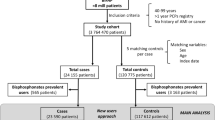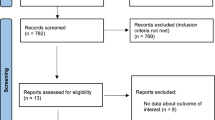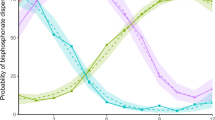Abstract
Summary
Concerns have been raised among clinicians and patients whether or not bisphosphonates increase the risk of atrial fibrillation. In this large cohort study, increased risk of atrial fibrillation was not found to be associated with bisphosphonate. In fact, bisphosphonate even showed a protective effect against cardiac arrhythmia compared to other osteoporosis medications.
Introduction
Increased risk of atrial fibrillation among bisphosphonate users has been reported; however, the results from these studies are controversial. The purpose of this study was to evaluate the risk of atrial fibrillation associated with bisphosphonate use in older women.
Methods
We used the Korean Health Insurance Review and Assessment Service claims database from May 1, 2005 to June 30, 2006. Retrospective cohort analysis was conducted on women 65 years or older with newly diagnosed cases of osteoporosis (ICD 10 code: M80, M81) who had not previously taken any medications for osteoporosis. Bisphosphonate-exposed and non-exposed patients were followed until they were either diagnosed with atrial fibrillation (ICD 10 code: I48) or until the end of the study. The Cox proportional hazards model was used to calculate hazard ratios and the 95% confidence intervals.
Results
Atrial fibrillation was reported in 626 of the 120,319 patients (0.52%) treated with bisphosphonates and 66 of 9,863 patients (0.67%) treated with other osteoporosis medications. Overall hazard ratio for developing atrial fibrillation in the bisphosphonate-treated group was 0.52 (95% CIs, 0.29–0.91). In patients with a medication possession ratio greater than 0.7, the hazard ratio was lower (HR 0.41, 95% CIs 0.23–0.75). In the subgroup analysis, alendronate showed a statistically significant protective effect against the risk of atrial fibrillation with a hazard ratio of 0.75 (95% CI, 0.58–0.97).
Conclusion
Among older Korean women with osteoporosis, bisphosphonate was found to have a protective effect against atrial fibrillation.

Similar content being viewed by others
Explore related subjects
Discover the latest articles and news from researchers in related subjects, suggested using machine learning.References
Black DM, Cummings SR, Karpf DB, Cauley JA, Thompson DE, Nevitt MC, Bauer DC, Genant HK, Haskell WL, Marcus R, Ott SM, Torner JC, Quandt SA, Reiss TF, Ensrud KE (1996) Randomised trial of effect of alendronate on risk of fracture in women with existing vertebral fractures. Fracture intervention trial research group. Lancet 348:1535–1541
Harris ST, Watts NB, Genant HK, McKeever CD, Hangartner T, Keller M, Chesnut CH 3rd, Brown J, Eriksen EF, Hoseyni MS, Axelrod DW, Miller PD (1999) Effects of risedronate treatment on vertebral and nonvertebral fractures in women with postmenopausal osteoporosis: a randomized controlled trial. Vertebral Efficacy With Risedronate Therapy (VERT) study group. JAMA 282:1344–1352
Reginster J, Minne HW, Sorensen OH, Hooper M, Roux C, Brandi ML, Lund B, Ethgen D, Pack S, Roumagnac I, Eastell R (2000) Randomized trial of the effects of risedronate on vertebral fractures in women with established postmenopausal osteoporosis. Vertebral Efficacy with Risedronate Therapy (VERT) study group. Osteoporos Int 11:83–91
Aapro M, Abrahamsson PA, Body JJ, Coleman RE, Colomer R, Costa L, Crinò L, Dirix L, Gnant M, Gralow J, Hadji P, Hortobagyi GN, Jonat W, Lipton A, Monnier A, Paterson AH, Rizzoli R, Saad F, Thürlimann B (2008) Guidance on the use of bisphosphonates in solid tumours: recommendations of an international expert panel. Ann Oncol 19:420–432
Black DM, Delmas PD, Eastell R, Reid IR, Boonen S, Cauley JA, Cosman F, Lakatos P, Leung PC, Man Z, Mautalen C, Mesenbrink P, Hu H, Caminis J, Tong K, Rosario-Jansen T, Krasnow J, Hue TF, Sellmeyer D, Eriksen EF, Cummings SR, HORIZON Pivotal Fracture Trial (2007) Once-yearly zoledronic acid for treatment of postmenopausal osteoporosis. N Engl J Med 356:1809–1822
Cummings S, Schwartz A, Black D (2007) Alendronate and atrial fibrillation [Letter]. N Engl J Med 356:1895–1896
Lloyd-Jones DM, Wang TJ, Leip EP, Larson MG, Levy D, Vasan RS, D'Agostino RB, Massaro JM, Beiser A, Wolf PA, Benjamin EJ (2004) Lifetime risk for development of atrial fibrillation: the framingham heart study. Circulation 110:1042–1046
Kopecky SL, Gersh BJ, McGoon MD, Chu CP, Ilstrup DM, Chesebro JH, Whisnant JP (1999) Lone atrial fibrillation in elderly persons: a marker for cardiovascular risk. Arch Intern Med 159:1118–1122
Sørensen HT, Christensen S, Mehnert F, Pedersen L, Chapurlat RD, Cummings SR, Baron JA (2008) Use of bisphosphonates among women and risk of atrial fibrillation and flutter: population based case-control study. BMJ 336:813–816
Bunch TJ, Anderson JL, May HT, Muhlestein JB, Horne BD, Crandall BG, Weiss JP, Lappé DL, Osborn JS, Day JD (2009) Relation of bisphosphonate therapies and risk of developing atrial fibrillation. Am J Cardiol 103:824–828
Huang WF, Tsai YW, Wen YW, Hsiao FY, Kuo KN, Tsai CR (2010) Osteoporosis treatment and atrial fibrillation: alendronate versus raloxifene. Menopause 17:57–63
Abrahamsen B, Eiken P, Brixen K (2009) Atrial fibrillation in fracture patients treated with oral bisphosphonates. J Intern Med 265:581–592
Loke Y, Jeevanantham V, Singh S (2009) Bisphosphonates and atrial fibrillation: systematic review and meta-analysis. Drug Saf 32:219–228
Bhuriya R, Singh M, Molnar J, Arora R, Khosla S (2010) Bisphosphonate use in women and the risk of atrial fibrillation: a systematic review and meta-analysis. Int J Cardiol 142:213–217
Gates BJ, Sonnett TE, DuVall CA, Dobbins EK (2009) Review of osteoporosis pharmacotherapy for geriatric patients. Am J Geriatr Pharmacother 7:293–323
von der Recke P, Hansen M, Hassager C (1999) The association between low bone mass at the menopause and cardiovascular mortality. Am J Med 106:273–278
Fuster V, Rydén LE, Cannom DS et al (2006) ACC/AHA/ESC 2006 guidelines for the management of patients with atrial fibrillation: a report of the American College of Cardiology/American Heart Association Task Force on Practice Guidelines and the European Society of Cardiology Committee for Practice Guidelines (Writing Committee to Revise the 2001 Guidelines for the Management of Patients With Atrial Fibrillation). J Am Coll Cardiol 48:854–906
Heckbert SR, Li G, Cummings SR, Smith NL, Psaty BM (2008) Use of alendronate and risk of incident atrial fibrillation in women. Arch Intern Med 168:826–831
Tankó LB, Christiansen C, Cox DA, Geiger MJ, Mcnabb MA, Cummings SR (2005) Relationship between osteoporosis and cardiovascular disease in postmenopausal women. J Bone Miner Res 20:1912–1920
Vasikaran SD (2001) Bisphosphonates: an overview with special reference to alendronate. Ann Clin Biochem 38:608–623
Hewitt RE, Lissina A, Green AE, Slay ES, Price DA, Sewell AK (2005) The bisphosphonate acute phase response: rapid and copious production of proinflammatory cytokines by peripheral blood gd T cells in response to aminobisphosphonates is inhibited by statins. Clin Exp Immunol 139:101–111
Roelofs A, Thompson K, Gordon S, Rogers MJ (2006) Molecular mechanisms of action of bisphosphonates: current status. Clin Cancer Res 12:6222s–6230s
Sauty A, Pecherstorfer M, Zimmer-Roth I, Fioroni P, Juillerat L, Markert M, Ludwig H, Leuenberger P, Burckhardt P, Thiebaud D (1996) Interleukin-6 and tumor necrosis factor alpha levels after bisphosphonates treatment in vitro and in patients with malignancy. Bone 18:133–139
Schweitzer D, Oostendorp-Van De Ruit M, Van der Pluijm G, Löwik CW, Papapoulos SE (1995) Interleukin-6 and the acute phase response during treatment of patients with Paget's disease with the nitrogen-containing bisphosphonate dimethylamino hydroxypropylidene bisphosphonate. J Bone Miner Res 10:956–962
Celiloglu M, Aydin Y, Balci P, Kolamaz T (2009) The effect of alendronate sodium on carotid artery intima-media thickness and lipid profile in women with postmenopausal osteoporosis. Menopause 16:689–693
Kronzon I, Tunick PA (2006) Aortic atherosclerotic disease and stroke. Circulation 114:63–75
Ylitalo R, Mönkkönen J, Urtti A, Ylitalo P (1996) Accumulation of bisphosphonates in the aorta and some other tissues of healthy and atherosclerotic rabbits. J Lab Clin Med 127:200–206
Ylitalo R, Kalliovalkama J, Wu X, Kankaanranta H, Salenius JP, Sisto T, Lähteenmäki T, Ylitalo P, Pörsti I (1998) Accumulation of bisphosphonates in human artery and their effects on human and rat arterial function in vitro. Pharmacol Toxicol 83:125–131
Luckish A, Cernes R, Boaz M, Gavish D, Matas Z, Fux A, Shargorodsky M (2008) Effect of long-term treatment with risedronate on arterial compliance in osteoporotic patients with cardiovascular risk factors. Bone 43:279–283
Montagnani A, Gonnelli S, Cepollaro C, Campagna MS, Franci MB, Pacini S, Gennari C (2003) Changes in serum HDL and LDL cholesterol in patients with Paget's bone disease treated with pamidronate. Bone 32:15–19
Guney E, Kisakol G, Ozgen AG, Yilmaz C, Kabalak T (2008) Effects of bisphosphonates on lipid metabolism. Neuro Endocrinol Lett 29:252–255
Adami S, Braga V, Guidi G, Gatti D, Gerardi D, Fracassi E (2000) Chronic intravenous aminobisphosphonate therapy increases high-density lipoprotein cholesterol and decreases low-density lipoprotein cholesterol. J Bone Miner Res 15:599–604
Watts NB, Diab DL (2010) Long-term use of bisphosphonates in osteoporosis. J Clin Endocrinol Metab 95:1555–1565
Russell RG (2007) Bisphosphonates: mode of action and pharmacology. Pediatrics 119(suppl .2):150–162
Rodan G, Reszka A, Golub E, Rizzoli R (2004) Bone safety of long-term bisphosphonate treatment. Curr Med Res Opin 20:1291–1300
Geusens P (2009) Bisphosphonates for postmenopausal osteoporosis: determining duration of treatment. Curr Osteoporos Rep 7:12–17
Jeong JH (2005) Prevalence of and risk factors for atrial fibrillation in Korean adults older than 40 years. J Korean Med Sci 20:26–30
Acknowledgments
This study was supported by a grant from the Korean Food and Drug Administration (07072KFDA224).
Conflicts of interest
None.
Author information
Authors and Affiliations
Corresponding author
Additional information
An erratum to this article can be found at http://dx.doi.org/10.1007/s00198-011-1841-5
Rights and permissions
About this article
Cite this article
Rhee, C.W., Lee, J., Oh, S. et al. Use of bisphosphonate and risk of atrial fibrillation in older women with osteoporosis. Osteoporos Int 23, 247–254 (2012). https://doi.org/10.1007/s00198-011-1608-z
Received:
Accepted:
Published:
Issue Date:
DOI: https://doi.org/10.1007/s00198-011-1608-z




